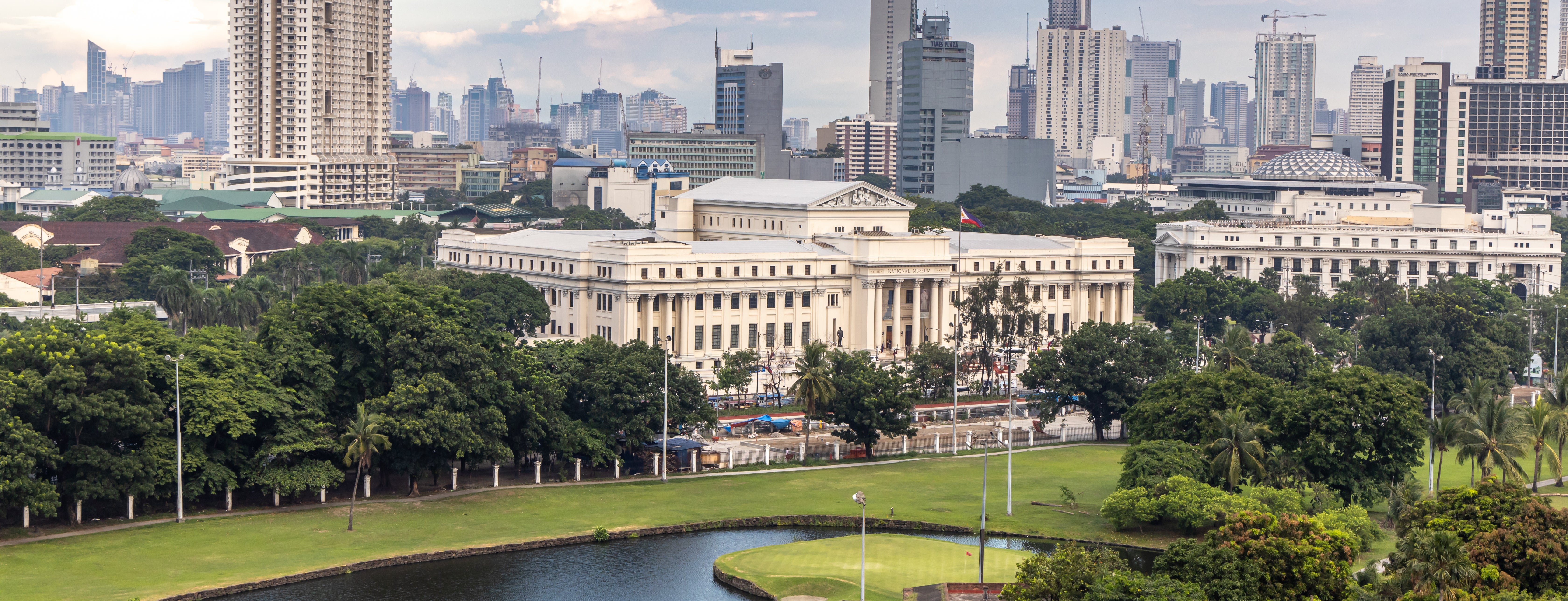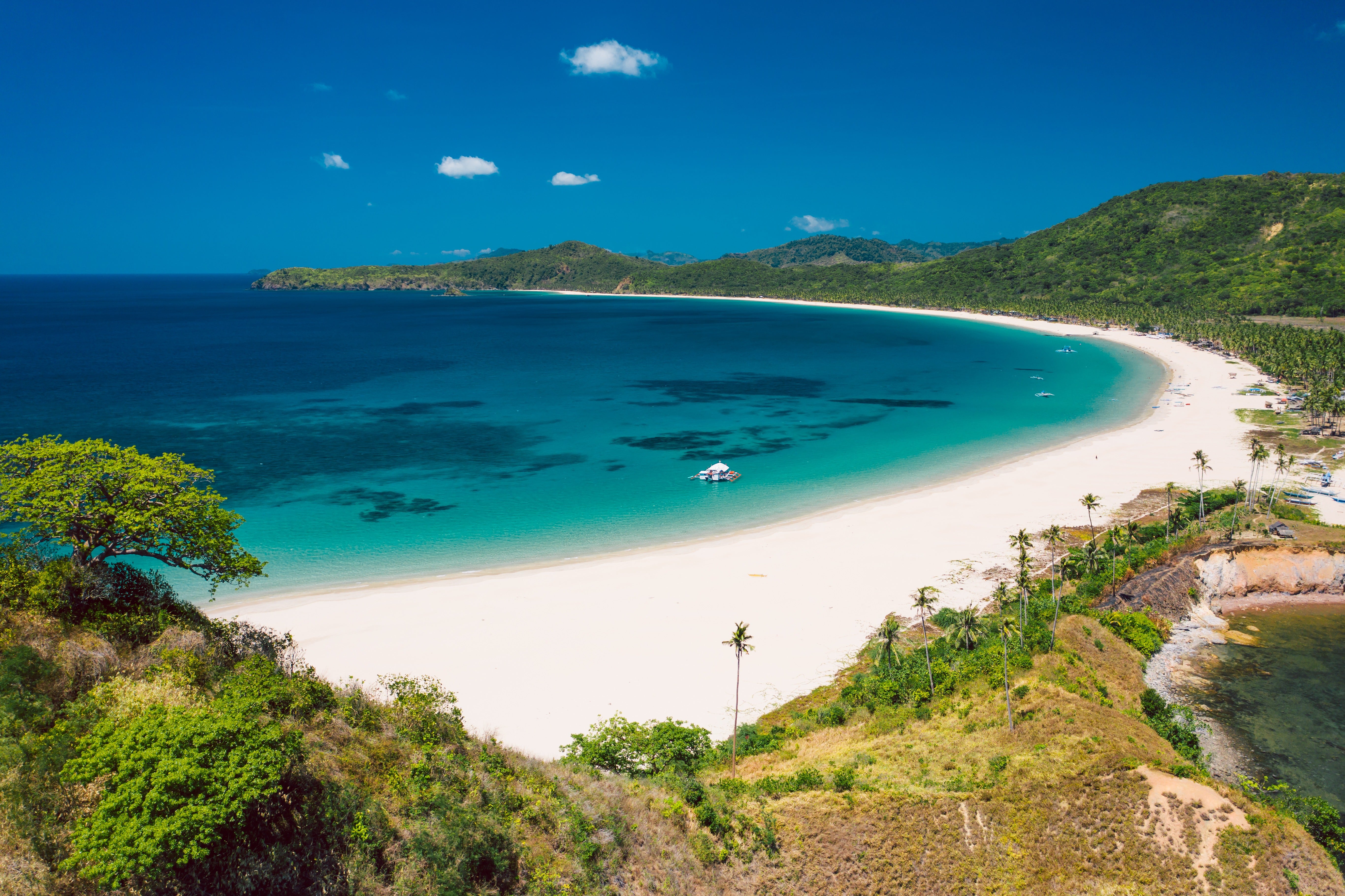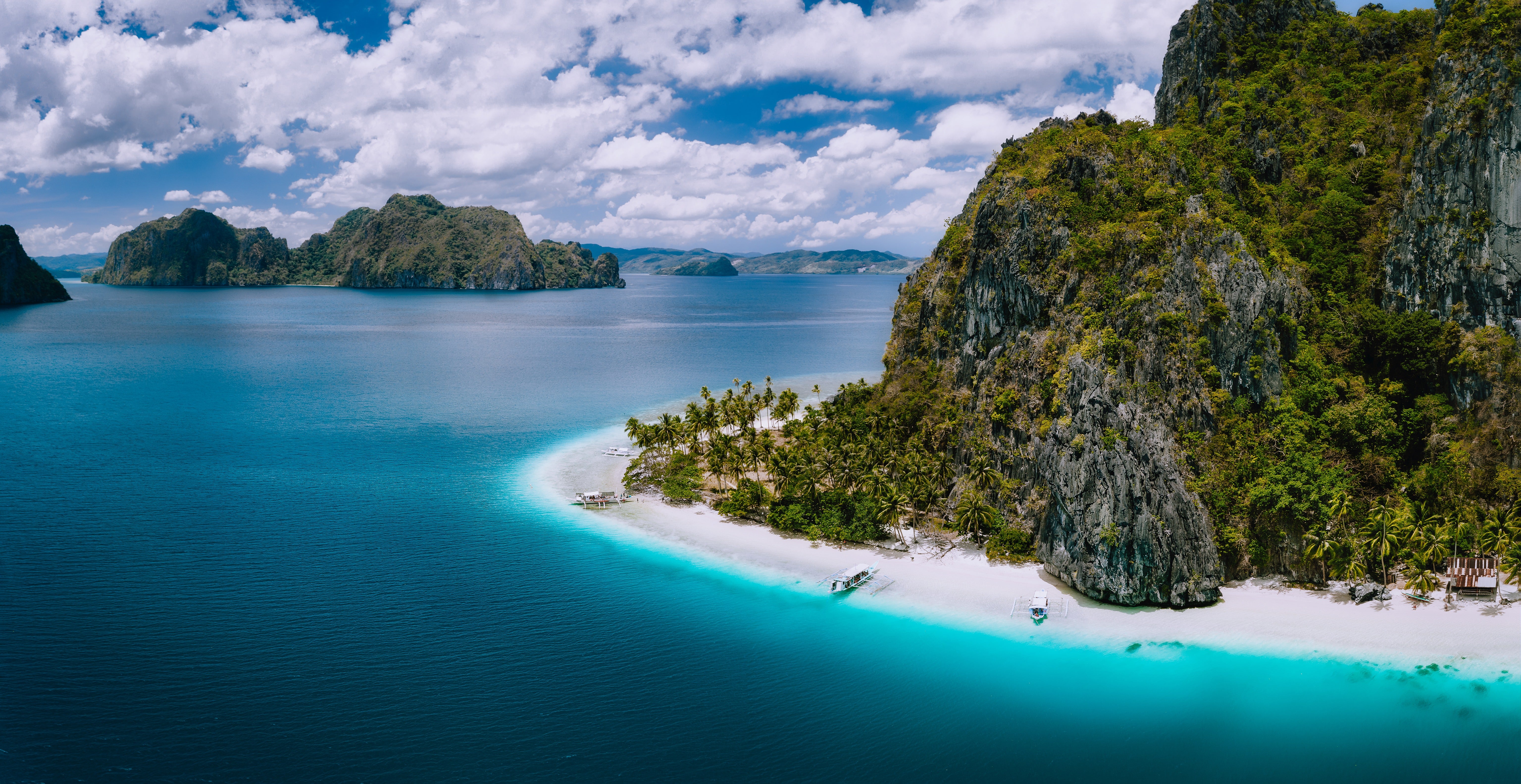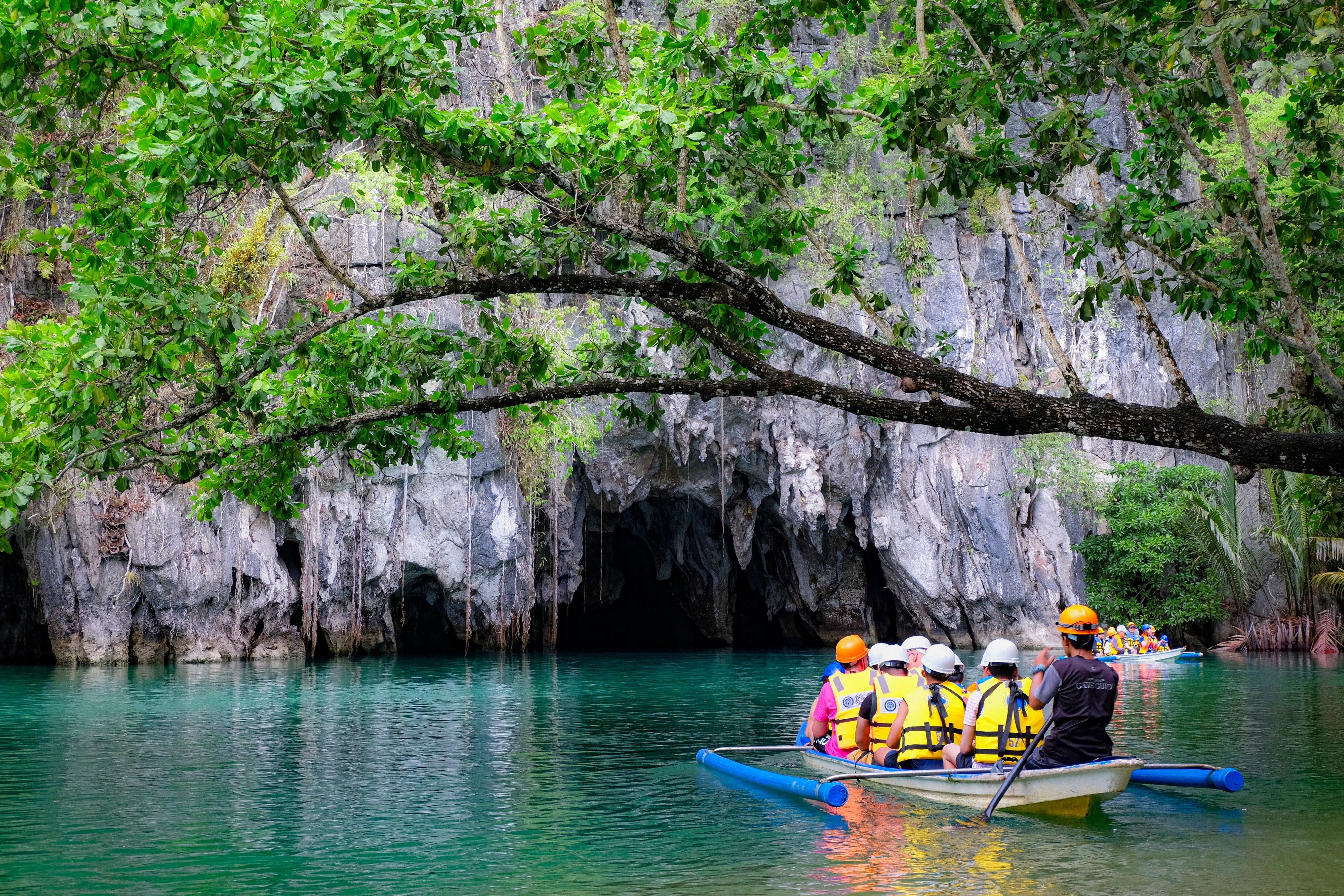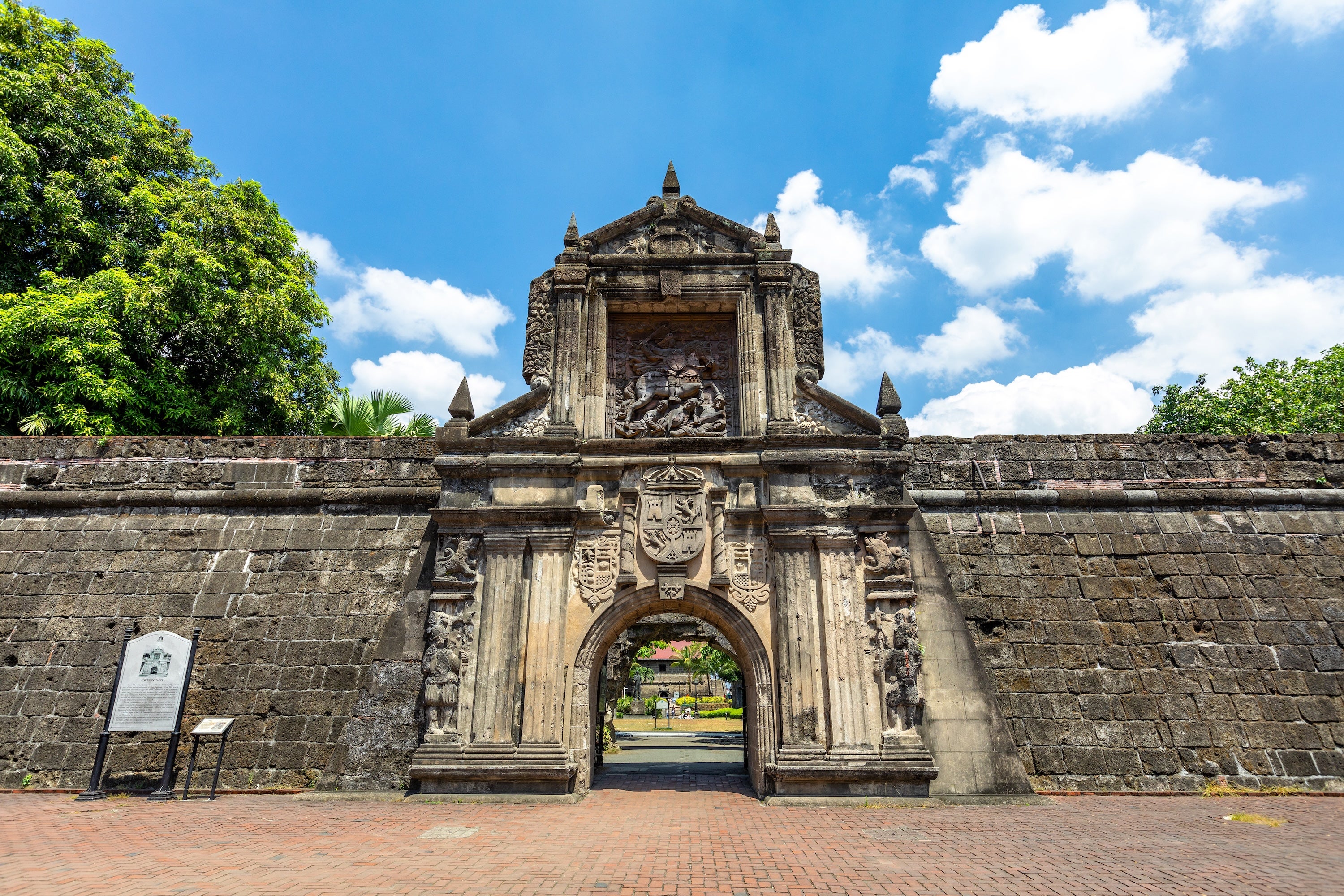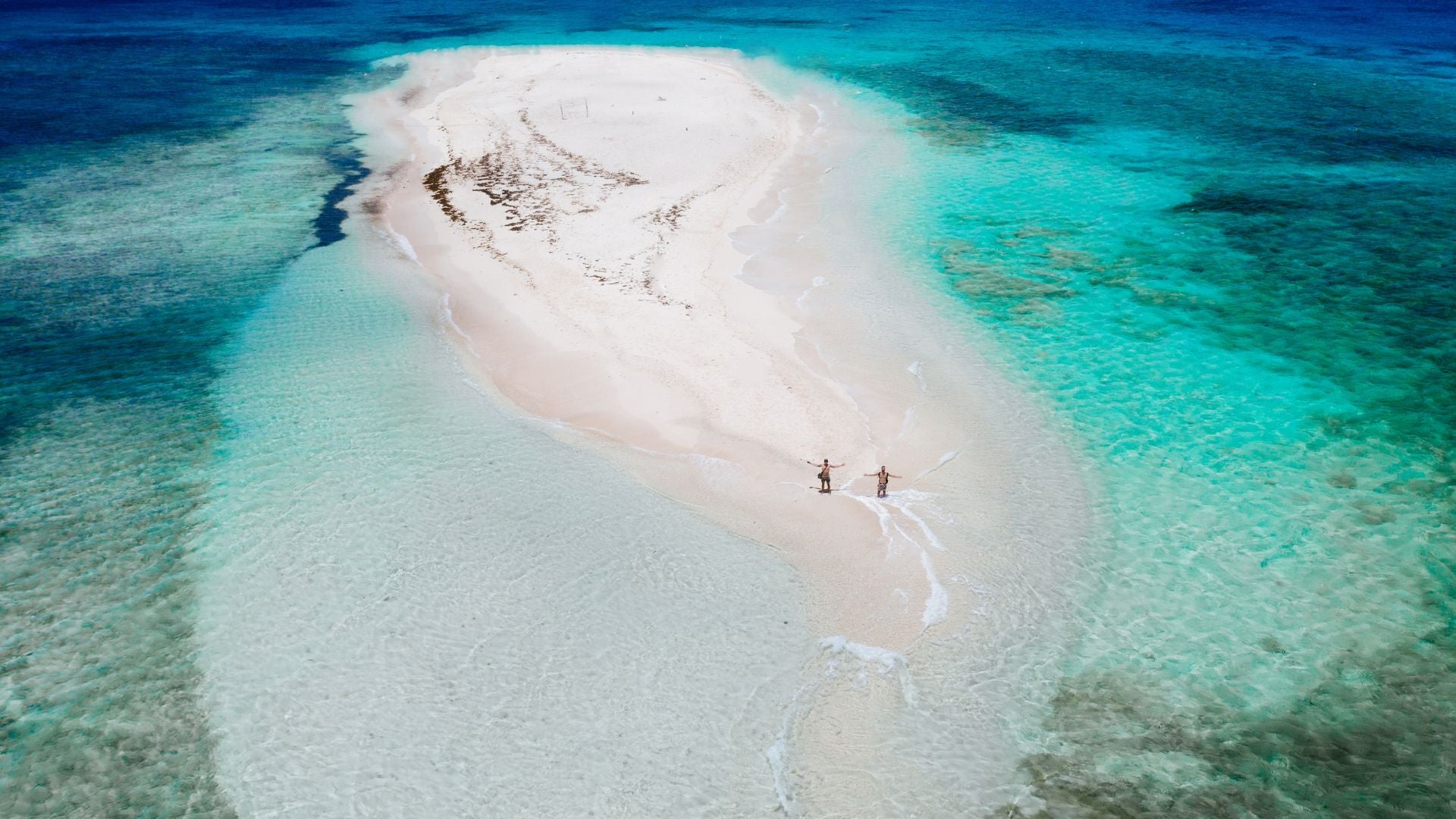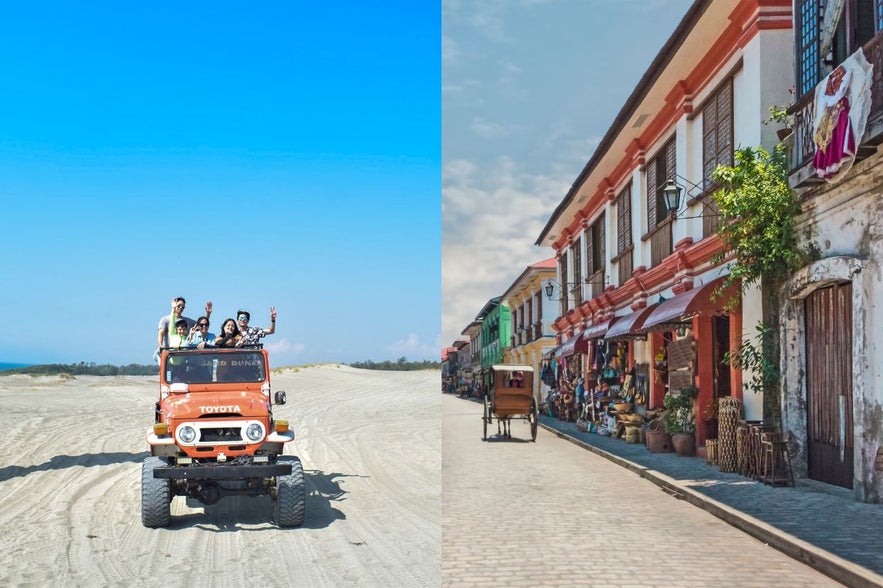
Beyond its famous beaches and islands, the Philippines offers travelers a glimpse into its storied past — a fusion of Asian, European, and indigenous influences seen in its architecture, festivals, and traditions.
One of the best regions to experience this cultural richness is Ilocos, located in the northwestern part of Luzon Island, north of the capital Manila City. Composed of the provinces of Ilocos Sur and Ilocos Norte, this destination is often referred to as a living museum — where UNESCO World Heritage towns, Baroque churches, and scenic coastlines come together to showcase the Philippines’ timeless beauty.
You can explore these historic provinces in depth with a pre-arranged 8-Day Ilocos Region History, Heritage & Nature Tour Package, which includes flights from Manila City, guided tours, accommodations, and private transfers for a seamless and immersive travel experience.
Whether you’re fascinated by history, architecture, or breathtaking nature, Ilocos Sur and Norte provinces offers one of the most authentic cultural experiences in the Philippines. For more options to explore this historic region, browse curated Ilocos Region tour packages featuring multi-day itineraries that blend heritage, adventure, and relaxation in Northern Luzon.
This Ilocos itinerary travel guide will walk you through everything you need to know so you can plan your own unforgettable journey through Ilocos Sur and Ilocos Norte provinces.
Key Takeaways:
-
The Ilocos Region offers a perfect mix of culture, history, and natural beauty. From the Spanish-era charm of Vigan City to the dramatic coastal landscapes of Ilocos Norte Province, travelers can explore centuries-old heritage houses, UNESCO sites, and breathtaking seaside views in just one trip.
-
Laoag City serves as the ideal starting point for exploring the Ilocos Region. It’s accessible by both air and land from Manila City and connects easily to nearby destinations like the towns of Paoay, Pagudpud, and Vigan City.
-
The best time to visit Ilocos Province is from November to May, when the weather is pleasant and ideal for sightseeing and outdoor adventures. This dry season is perfect for visiting beaches, sand dunes, and historical attractions.
-
Among the top attractions in Ilocos are Vigan City’s Calle Crisologo with its cobblestone streets and ancestral houses, Paoay Church which is recognized as a UNESCO World Heritage Site, the Bangui Windmills and Patapat Viaduct in Pagudpud town, and Malacañang of the North and the sand dunes in Laoag City.
-
Ilocos cuisine is another highlight, featuring local favorites such as bagnet or crispy pork belly, empanada filled with vegetables and sausage, and pinakbet, a mixed vegetable stew cooked in shrimp paste.
-
A one-week trip allows travelers to fully experience both Ilocos Norte and Ilocos Sur provinces at a relaxed pace, with plenty of time to enjoy cultural landmarks, beaches, and local delicacies.
Sample 1-Week Ilocos Sur and Norte Provinces Itinerary
This 1-week Ilocos itinerary is designed for travelers who want to experience the best of the provinces in just a few days. It combines cultural heritage tours, scenic outdoor adventures, and relaxing coastal escapes—so you can make the most of your time exploring both provinces of Ilocos Norte and Ilocos Sur without feeling rushed.
If you’re planning a weeklong trip, this suggested route offers a smooth and convenient timeline—from historic landmarks in Laoag City and the sand dunes of Paoay town, to the beaches of Pagudpud and the cobblestone streets of Vigan City.
Day 1: Arrival in Manila City and Optional Historical Tours
Arrive in Manila City and check in at your hotel. Explore the capital with any of these optional tours:
Day 2: Flight to Laoag City
Fly from Manila to Laoag City, the gateway to Ilocos Norte Province. Check in at your hotel and enjoy a relaxing first evening.
Day 3: Laoag City Heritage & Sand Dunes Adventure Tour
Visit St. William’s Cathedral, Paoay Church, and Malacañang of the North, then end the day with a thrilling Paoay Sand Dunes 4x4 ride.
Day 4: Ilocos Norte Province Scenic Tour with Pagudpud Beach
See Cape Bojeador Lighthouse, Bangui Windmills, and Kapurpurawan Rock Formation before relaxing at Pagudpud Beach.
Day 5: Travel to Vigan City and Optional Cultural Experiences
Head to Ilocos Sur Province's Vigan City, a UNESCO World Heritage Site known for its preserved Spanish-colonial streets. Enjoy optional experiences like:
-
Traditional Filipino Attire Rental at Villa Angela Heritage House
-
Traditional Filipino Attire Rental & 5-Course Ilocano Dinner at Villa Angela Heritage House
Day 6: Vigan City Heritage & Cultural Tour
Explore Calle Crisologo street, Bantay Church, Syquia Mansion, and Pagburnayan Pottery Workshop. End with a horse-drawn carriage ride around the old town.
Day 7: Return to Manila City via Flight
Fly back to Manila City and enjoy a free evening for shopping or dining before departure.
Day 8: Departure from Manila City
Check out of your hotel and head to the airport for your flight home.
For a worry-free trip, you can book pre-arranged or customized Philippine vacation packages that include flights, accommodations, and tours to top destinations across the country.
If you want to focus your trip on the north, check out Ilocos tours to explore Vigan City’s heritage streets, Laoag’s historical landmarks, and Pagudpud town’s scenic coastlines—all in one unforgettable cultural journey.
Day 1: Manila City
Your Ilocos adventure often begins in Manila City, the bustling capital of the Philippines and the country’s main international gateway. Most travelers arrive here first before taking a connecting flight to Laoag City, the primary entry point to the Ilocos Region in Northern Luzon.
If you’re spending a night or two in Manila City before heading north, take the opportunity to experience a glimpse of the city’s colorful mix of old and new. You can stroll through its busy streets, explore shopping and dining districts, or unwind at your hotel after your long flight.
For those eager to start sightseeing, join a guided walking tour of Intramuros, the historic walled city that showcases Spanish colonial-era churches, fortresses, and cobblestone streets that tell centuries of Philippine history. Another great option is a Binondo Chinatown food tour, where you can sample a fusion of Filipino and Chinese flavors in the oldest Chinatown in the world.
Whether you choose to relax or explore, your stay in Manila sets the stage for your upcoming cultural journey through the Ilocos Region.
Day 2: Laoag City

From Manila City, your journey to the Ilocos Region begins. The most convenient way to reach Laoag City, the capital of Ilocos Norte Province and the gateway to the region's attractions, is by air. Daily flights from Ninoy Aquino International Airport (NAIA) or Manila Airport take around an hour, making it the fastest option for travelers on a tight schedule.
If you have more time and want to see the countryside, you can also travel to Laoag City by land. Several bus lines operate daily routes from Manila City to Laoag, with travel times of around 8 to 10 hours. It’s a longer trip, but it offers scenic views of Luzon region’s northern landscapes along the way.
Once you arrive in Laoag City, settle into your hotel and take the rest of the day at your own pace. You can relax after the long trip or explore the city center, which features a mix of Spanish-era architecture and modern Filipino life.
Don’t miss the chance to try authentic Ilocano dishes, known for their bold and savory flavors. Must-tries include pinakbet (vegetable stew in shrimp paste), bagnet (crispy fried pork belly), dinardaraan (pork blood stew), and sarabasab (grilled pork liver). Pair your meal with rice and a refreshing glass of calamansi juice for the perfect Ilocano dining experience.
Whether you choose to fly or travel by land, Laoag City is the perfect starting point for discovering the history, culture, and natural beauty of Northern Luzon region.
Day 3: Exploring Laoag City and Nearby Attractions
Spend your third day discovering Laoag City, the capital of Ilocos Norte Province, known for its well-preserved heritage landmarks and scenic surroundings. You can explore the city at your own pace or join a guided tour to make the most of your time. Many attractions are located close to each other, making it easy to combine several stops in one day.
St. William’s Cathedral and the Sinking Bell Tower
 Start your city exploration at St. William’s Cathedral, a centuries-old Roman Catholic church and one of Laoag’s most recognizable landmarks. Just a short walk away stands the Sinking Bell Tower, famous for gradually sinking into the ground each year due to the city’s soft soil. Both sites are perfect for travelers interested in history, architecture, and photography.
Start your city exploration at St. William’s Cathedral, a centuries-old Roman Catholic church and one of Laoag’s most recognizable landmarks. Just a short walk away stands the Sinking Bell Tower, famous for gradually sinking into the ground each year due to the city’s soft soil. Both sites are perfect for travelers interested in history, architecture, and photography.
Malacañang of the North and Paoay Lake
 Drive about 20 minutes southwest to Paoay, a town rich in culture and historical charm. Here, you’ll find Malacañang of the North, a two-story mansion overlooking Paoay Lake. Once the holiday residence of former President Ferdinand Marcos, it now serves as a museum that offers a glimpse into the political and cultural history of the region.
Drive about 20 minutes southwest to Paoay, a town rich in culture and historical charm. Here, you’ll find Malacañang of the North, a two-story mansion overlooking Paoay Lake. Once the holiday residence of former President Ferdinand Marcos, it now serves as a museum that offers a glimpse into the political and cultural history of the region.
Paoay Church (San Agustin Church)
 Not far from the mansion stands Paoay Church, a UNESCO World Heritage Site and one of the most beautiful examples of Baroque architecture in Asia. Its massive buttresses were designed to withstand earthquakes—an ingenious fusion of European and local building styles. Take a few moments to admire its intricate facade or step inside to appreciate its serene interior.
Not far from the mansion stands Paoay Church, a UNESCO World Heritage Site and one of the most beautiful examples of Baroque architecture in Asia. Its massive buttresses were designed to withstand earthquakes—an ingenious fusion of European and local building styles. Take a few moments to admire its intricate facade or step inside to appreciate its serene interior.
Ilocos Sand Dunes
 Photo by Department of Tourism
Photo by Department of Tourism
For a change of pace, head to the Ilocos Sand Dunes, a vast coastal desert that stretches between the towns of Paoay and Currimao. You can simply enjoy the panoramic sea views or join a 4x4 sand dunes ride for an exhilarating adventure across the rolling sands—a must-try experience for thrill-seekers visiting Ilocos Norte.
Batac Museum and Empanadahan
Before returning to Laoag City, make a stop in Batac, a nearby town with deep political roots. The Batac Museum houses exhibits on Ilocos Norte’s prominent historical figures, while the Batac Empanadahan across the street is the perfect place to sample the famous Ilocos empanada—a crispy deep-fried pastry filled with vegetables, egg, and local sausage.
With a mix of historical landmarks, cultural heritage, and outdoor fun, Laoag City offers something for every type of traveler. You can explore independently, hire a private car, or join a day tour to conveniently cover multiple stops in one day.
Day 4: Ilocos Norte Province
Spend your fourth day exploring the northern tip of Ilocos Norte Province, where dramatic coastlines, historic landmarks, and striking natural wonders come together. This area is ideal for a full-day road trip from Laoag City, with each stop offering a mix of scenic views and cultural significance.
Whether you join a guided tour or explore at your own pace, this route is one of the most rewarding ways to experience Northern Luzon.
Kapurpurawan Rock Formation
 The Kapurpurawan Rock Formation, one of Ilocos Norte’s most unique natural landmarks. Formed by centuries of wind and sea erosion, its gleaming white limestone curves look almost sculpted by hand. You can take a short hike to the viewing decks, walk along the pathways, and capture photos with the stunning contrast of ivory rocks against the deep blue ocean.
The Kapurpurawan Rock Formation, one of Ilocos Norte’s most unique natural landmarks. Formed by centuries of wind and sea erosion, its gleaming white limestone curves look almost sculpted by hand. You can take a short hike to the viewing decks, walk along the pathways, and capture photos with the stunning contrast of ivory rocks against the deep blue ocean.
Cape Bojeador Lighthouse
 Next, head to Cape Bojeador Lighthouse in Burgos, the highest-elevated active lighthouse in the Philippines. Built during the Spanish colonial period, it continues to guide ships navigating the northern coastline. Climb up to its viewing platform to enjoy sweeping views of the South China Sea and the surrounding cliffs.
Next, head to Cape Bojeador Lighthouse in Burgos, the highest-elevated active lighthouse in the Philippines. Built during the Spanish colonial period, it continues to guide ships navigating the northern coastline. Climb up to its viewing platform to enjoy sweeping views of the South China Sea and the surrounding cliffs.
Bangui Wind Farm windmills
 Drive further along the coast to reach the Bangui Wind Farm, Southeast Asia’s first and largest wind power project. Its towering turbines stretch along the shoreline, creating a postcard-perfect view that blends technology with nature. Take your time strolling along the beach and snapping photos of the windmills silhouetted against the sky.
Drive further along the coast to reach the Bangui Wind Farm, Southeast Asia’s first and largest wind power project. Its towering turbines stretch along the shoreline, creating a postcard-perfect view that blends technology with nature. Take your time strolling along the beach and snapping photos of the windmills silhouetted against the sky.
Pagudpud Beach (Saud Beach)
 After sightseeing, unwind at Pagudpud town's Saud Beach, a laid-back seaside destination known for its fine white sand and crystal-clear waters. It’s the perfect spot to cool off, swim, or simply relax under the sun. The peaceful setting makes it a great contrast to the day’s more adventurous stops.
After sightseeing, unwind at Pagudpud town's Saud Beach, a laid-back seaside destination known for its fine white sand and crystal-clear waters. It’s the perfect spot to cool off, swim, or simply relax under the sun. The peaceful setting makes it a great contrast to the day’s more adventurous stops.
Patapat Viaduct
 End your tour at the Patapat Viaduct, an engineering marvel that curves gracefully along the cliffs of Pagudpud. This elevated coastal highway connects the Ilocos Region to the northern provinces of Cagayan Valley and offers one of the most scenic drives in the Philippines. Be sure to stop for photos—the view of the sea and mountains is breathtaking.
End your tour at the Patapat Viaduct, an engineering marvel that curves gracefully along the cliffs of Pagudpud. This elevated coastal highway connects the Ilocos Region to the northern provinces of Cagayan Valley and offers one of the most scenic drives in the Philippines. Be sure to stop for photos—the view of the sea and mountains is breathtaking.
With a blend of coastal landscapes, historic landmarks, and quiet seaside charm, Ilocos Norte offers an unforgettable day of exploration. You can rent a private car for convenience, join a day tour with local guides, or design your own route based on your travel pace.
Day 5: Travel to Vigan City

After breakfast in Laoag City, continue your Ilocos region journey south toward Vigan City, located in Ilocos Sur Province. The drive takes around two to three hours, passing through scenic rural landscapes, coastal roads, and small towns that showcase the charm of Northern Luzon region.
Recognized as a UNESCO World Heritage Site, Vigan is one of the best-preserved Spanish colonial towns in Asia. Its cobblestone streets, ancestral homes, and horse-drawn carriages transport visitors back to the 16th century, offering a glimpse of the Philippines’ colonial past.
Despite its historical setting, the city is alive with vibrant markets, local restaurants, and cultural attractions that blend tradition with modern Filipino hospitality.
Once you arrive, check in at your hotel and take the rest of the day at your leisure. You can stroll around the city plaza, admire heritage architecture, or simply relax in one of the cafés along Calle Crisologo, Vigan’s most iconic street.
 For a taste of Ilocano cuisine, don’t miss local specialties like Vigan longganisa (garlic sausage), Ilocos empanada, and bagnet, best enjoyed in one of the city’s homegrown restaurants.
For a taste of Ilocano cuisine, don’t miss local specialties like Vigan longganisa (garlic sausage), Ilocos empanada, and bagnet, best enjoyed in one of the city’s homegrown restaurants.
Whether you choose to spend your time walking around historic streets, sampling Ilocano food, or unwinding at your hotel, Vigan City offers a perfect mix of relaxation, history, and timeless charm.
Day 6: Exploring Vigan City’s Heritage Attractions
Your sixth day in Ilocos can be dedicated to exploring the heart of Vigan City, a living museum of Philippine history and culture. Whether you join a local heritage tour or explore on your own, you’ll find that nearly every corner of the city has a story to tell—from its Spanish colonial architecture to its enduring artisan traditions.
Vigan National Museum (Padre Burgos House)
Begin your cultural discovery at the Vigan National Museum, also known as Padre Burgos House. This 19th-century ancestral home is the birthplace of Padre José Burgos, one of the Filipino priests martyred during the Spanish era. Today, the museum showcases a collection of period furniture, antique household items, and historical artifacts that illustrate the Ilocano way of life in the 1800s.
National Museum of the Philippines – Ilocos
 Another excellent stop for history enthusiasts is the National Museum Ilocos, which features ethnographic exhibits, local crafts, and archeological finds from the region. Its displays celebrate the artistry and craftsmanship that define Ilocano identity, making it a great complement to the Padre Burgos House.
Another excellent stop for history enthusiasts is the National Museum Ilocos, which features ethnographic exhibits, local crafts, and archeological finds from the region. Its displays celebrate the artistry and craftsmanship that define Ilocano identity, making it a great complement to the Padre Burgos House.
Calle Crisologo Street and Horse-Drawn Carriage Ride
 Photo by Department of Tourism
Photo by Department of Tourism
No visit to Vigan is complete without walking or riding through Calle Crisologo, the city’s most famous cobblestone street. Lined with well-preserved Spanish-era houses, this stretch feels like stepping back in time. Hop on a kalesa, a traditional horse-drawn carriage, to see the heritage houses, souvenir shops, and cafés from a classic colonial perspective.
Bantay Church and Bell Tower
 Just a short drive from the city center stands Bantay Church, officially known as the Shrine of Our Lady of Charity, one of the oldest churches in the region. Climb the Bantay Bell Tower, which once served as a watchtower during wartime, for panoramic views of Vigan and the surrounding countryside.
Just a short drive from the city center stands Bantay Church, officially known as the Shrine of Our Lady of Charity, one of the oldest churches in the region. Climb the Bantay Bell Tower, which once served as a watchtower during wartime, for panoramic views of Vigan and the surrounding countryside.
Baluarte Zoo
If you’re traveling with family or want to see a different side of Vigan, visit Baluarte Zoo, a sprawling sanctuary owned by a local politician. It’s home to a wide variety of animals, from native species to exotic wildlife, and offers interactive experiences such as feeding sessions and photo opportunities.
Pagburnayan Jar Factory
 Head to the Pagburnayan Jar Factory, one of Vigan’s most beloved cultural stops. Here, local artisans demonstrate the centuries-old art of pottery-making using traditional methods passed down through generations. Visitors can watch how the famous burnay jars are shaped from clay—or even try molding one yourself.
Head to the Pagburnayan Jar Factory, one of Vigan’s most beloved cultural stops. Here, local artisans demonstrate the centuries-old art of pottery-making using traditional methods passed down through generations. Visitors can watch how the famous burnay jars are shaped from clay—or even try molding one yourself.
St. Paul Metropolitan Cathedral
 Before ending your day, stop by the St. Paul Metropolitan Cathedral, also known as the Vigan Cathedral. This Baroque-style church, located near Plaza Salcedo, is a focal point of the city’s religious and social life. Step inside for a quiet moment of reflection or admire its grand facade illuminated at night.
Before ending your day, stop by the St. Paul Metropolitan Cathedral, also known as the Vigan Cathedral. This Baroque-style church, located near Plaza Salcedo, is a focal point of the city’s religious and social life. Step inside for a quiet moment of reflection or admire its grand facade illuminated at night.
After a full day of sightseeing, unwind at your hotel or dine in one of the city’s charming heritage restaurants, many of which serve authentic Ilocano cuisine in restored colonial houses.
Day 7: Departure to Manila City
On your final day, start your morning with a relaxed breakfast at your hotel before checking out. If your schedule allows, take some time to explore a few nearby attractions or revisit your favorite local cafés and restaurants for one last taste of Ilocano cuisine. You can also drop by souvenir shops to pick up woven crafts, local delicacies, or handwoven fabrics that make for perfect keepsakes or gifts.
When it’s time to leave, head to the airport for your flight back to Manila City, the bustling capital of the Philippines. After your arrival, you’ll check in at your hotel and have the rest of the day free to unwind. You may choose to rest after your journey, explore nearby shopping malls, or dine at one of Manila’s many restaurants.
If you still have energy to spare, consider spending your evening experiencing Manila’s vibrant nightlife or visiting cultural attractions like Intramuros or the Baywalk for a relaxing sunset view. It’s the perfect way to wrap up your memorable Ilocos trip before your departure.
Frequently Asked Questions About Traveling in Ilocos Region
How do I get to the Ilocos Region from Manila?
The easiest way to reach the Ilocos Region is by flying from Manila to Laoag City, the main gateway to Ilocos Norte. The flight takes about one hour and is available through major airlines. Travelers who prefer land travel can also take provincial buses from Manila to Laoag or Vigan, which usually takes around eight to ten hours.
How many days do I need to explore Ilocos?
A 7- to 8-day itinerary is ideal for discovering both Ilocos Norte and Ilocos Sur at a comfortable pace. This allows you to explore historical landmarks in Laoag, scenic landscapes in Pagudpud, and heritage attractions in Vigan without rushing. Travelers who prefer a ready-made plan can also check out curated Ilocos Region tour packages that combine these highlights.
Can I customize my Ilocos itinerary?
Yes. You can easily personalize your Ilocos trip depending on your interests and schedule. Many travelers choose to combine historical tours in Vigan with outdoor adventures in Pagudpud or food and cultural activities in Laoag.
What is the best time to visit Ilocos?
The best time to visit the Ilocos Region is from November to May, during the dry season. This period offers sunny weather and calm seas—perfect for sightseeing, beach trips, and exploring the region’s outdoor landmarks.
What are the must-visit tourist attractions in Ilocos?
Top attractions include Vigan’s Calle Crisologo, Paoay Church, Malacañang of the North, Bangui Windmills, and Patapat Viaduct. These sites showcase the rich blend of Spanish colonial architecture, cultural heritage, and coastal scenery that the Ilocos Region is known for.
What should I pack for my Ilocos trip?
Light, breathable clothing is recommended, along with comfortable footwear for walking around heritage sites and natural attractions. Don’t forget sunscreen, sunglasses, and a hat for daytime tours, and a light jacket for cooler evenings.
What local food should I try in Ilocos?
Sample Ilocos specialties such as bagnet (crispy pork belly), Ilocos empanada, pinakbet (mixed vegetables cooked in shrimp paste), and longganisa (garlicky local sausage). For dessert, try royal bibingka, a sweet sticky rice cake that’s a regional favorite.
Is it easy to travel between Laoag, Pagudpud, and Vigan?
Yes. The major towns and cities in the Ilocos Region are connected by well-paved highways. You can travel between them via private car, van rental, or guided tour. Most visitors find it easy to move between attractions within a single day.
Why should I book an Ilocos vacation package instead of planning everything myself?
Booking a vacation package takes away the stress of organizing flights, hotels, and transfers separately. It ensures you have a seamless itinerary with pre-arranged tours, transportation, and accommodations—allowing you to simply enjoy your trip. Packages also often include exclusive deals and expert-guided experiences, giving you better value and convenience during your Ilocos adventure.
Plan Your Ilocos Region Adventure

From the historic streets of Vigan to the scenic coastlines of Pagudpud and the cultural landmarks of Laoag, the Ilocos Region beautifully captures the Philippines’ rich heritage and timeless charm. Whether you’re tracing centuries-old churches, admiring colonial architecture, or savoring authentic Ilocano dishes, every experience reveals a deeper connection to the country’s story.
A week in Ilocos offers a perfect mix of culture, history, and nature — from exploring UNESCO World Heritage sites to relaxing by sunlit beaches and rugged coastal cliffs. Beyond the attractions, it’s the warmth of the people and the enduring traditions that make Ilocos truly unforgettable.
Take your time exploring, embrace the slow pace of its heritage towns, and let the stories of the region unfold at every turn. Your journey through Ilocos is not just a trip — it’s a step back in time and a celebration of the Philippines’ living history.



